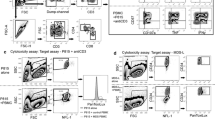Abstract
The expression of P-glycoprotein (Pgp) on normal human lymphocytes, and its drug exclusion capacity, implies that Pgp might be involved in cytokine secretion. We used two-color flow cytometry to detect simultaneously Pgp expression and IL-2 accumulation in resting and mitogen-activated human lymphocytes. Among resting lymphocytes from five healthy donors less than 1% were Pgp+ as determined by reactivity with the anti-Pgp monoclonal antibody (mAb) 4E3. The percentage of Pgp+ lymphocytes increased to 3% after 24 hr of mitogenic stimulation that induced maximal production of cytoplasmic IL-2. The percentage of lymphocytes that coexpressed membrane Pgp and cytoplasmic IL-2 accounted for <10% of the total IL-2 producing lymphocytes. Finally, mitogen-induced cytoplasmic IL-2 accumulation was enhanced by stimulation in the presence of monensin but not the Pgp functional inhibitor verapamil. Because mAb 4E3 detected lower than expected numbers of Pgp+ lymphocytes, we compared the binding of mAbs MRK16 and 4E3 concomitant with doxorubicin (DOX)-uptake by K562 and R7 tumor cells and purified CD8+ lymphocytes. The MRK16 mAb was found to be sensitive but not very specific (30%). In contrast, the sensitivity of 4E3 was equivalent to MRK16 (98%) and was highly specific (98.5%). There was also a positive association between DOX efflux and the level of Pgp expression as detected by 4E3 but not MRK16. Thus, human T cells do not markedly up-regulate their expression of functional Pgp molecules as detected by mAb 4E3 following activation, suggesting that Pgp does not play a major role in IL-2 secretion by activated T cells.
Similar content being viewed by others
REFERENCES
Endicott, JA, Ling V: The biochemistry of P-glycoprotein mediated multidrug resistance. Annu Rev Biochem 58:137, 1989
Biedler JL, Riehn H: Cellular resistance to actinomycin D in chinese hamster ovary cells in vitro: Cross resistance, radiographic, and cytogenetic studies. Cancer Res 39:1174, 1970
Cordon-Cardo C, O'Brien J, Boccia J, Casals D, Bertino JQ, Melamed MR: Expression of the multipledrug resistance gene product (P-glycoprotein) in human normal and tumor tissues. J Histochem Cytochem 38:1277, 1990
Gatmaitan Z, Arias I: Structure and function of P-glycoprotein in normal liver and small intestine. Adv Pharmacol 24:77, 1993
Chaudhary PM, Mechetner EB, Roninson IB: Expression and activity of the multidrug resistance P-glycoprotein in human peripheral blood lymphocytes. Blood 80:2735, 1992
Drach D, Zhao S, Drach J, Mahadevia R, Gattringer C, Huber H, Andreef M: Subpopulations of normal peripheral blood and bone marrow cells express a functional multidrug resistance phenotype. Blood 80:2729, 1992
Klimecki WT, Futscher BW, Grogan TM, Dalton WS: P-glycoprotein expression and function in circulating blood cells from normal volunteers. Blood 83:2451, 1994
Pilarski LM, Paine D, McEihaney JE, Cass CE, Belch AR: Multidrug transporter P-glycoprotein 170 as a differentiation antigen on normal human lymphocytes and thymocytes: Modulation with differentiation stage and during aging. Am J Hematol 49:323, 1995
Markham PN, Coon JS, Chong ASF, Gebel HM: Natural killer cell cytotoxicity and the multidrug resistance gene. Transplant Proc 25:26, 1993
Klimecki WT, Taylor CW, Dalton WS: Inhibition of cell-mediated cytolysis and P-glycoprotein function in natural killer cells by verapamil isomers and cyclosporine A analogs. J Clin Immunol 15:152, 1995
Gupta S, Gollapudi S: P-glycoprotein (MDR1 gene product) in cells of the immune system: Its possible physiologic role and alteration in aging and human immunodeficiency virus-1 (HIV-1) infection. J Clin Immunol 13:289, 1993
Kobayashi Y, Yamashiro T, Nagatake H, Yamamoto T, Watanabe N, Tanaka H, Shigenobu K, Tsuruo T: Expression and function of multidrug resistance P-glycoprotein in a cultured natural killer cell-rich population revealed by MRK-16 monoclonal antibody and AHC-52. Biochem Pharmacol 48:1641, 1994
Drach J, Gsur A, Hamilton G, Zhao S, Angerler J, Fiegl M, Zojer N, Raderer M, Haberl I, Andreeff M, Huber H: Involvement of P-glycoprotein in the transmembrane transport of interleukin-2 (IL-2), Il-4, and interferon-g in normal human T lymphocytes. Blood 88:1747, 1996
Gosland M, Lum BL, Sikic BI: Reversal by cefoperazone of resistance to etoposide, doxorubicin, and vinblastine in multidrug resistant human sarcoma cells. Cancer Res 49:6901, 1989
Elliott LH, Carlson SI, Morford LA, McGillis JP: Preparation, characterization, and use of human and rodent lymphocytes, monocytes, and neutrophils. Methods Neurosci 24:115, 1995
Takeshita A, Shinjo K, Ohnishi K, Ohno R: New flow cytometric method for detection of minimally expressed multidrug resistance P-glycoprotein on normal and acute leukemia cells using biotinylated MRK-16 and streptavidin-RED670 conjugate. Jpn J Cancer Res 86:607, 1995
Okochi E, Iwahashi T, Ariyoshi K, Watabe H, Tsuruo T, Ono K: Establishment and evaluation of MRK16-magnetic cell sorting assays for detecting low expression of multidrug resistance p-glycoprotein using human leukemia cell lines and peripheral blood cells from healthy donors. J Immunol Methods 187:127, 1995
Rao VV, Anthony DC, Piwnica-Worms D: Multidrug resistance P-glycoprotein monoclonal antibody JSB-1 crossreacts with pyruvate carboxylase. J Histochem Cytochem 43:1187, 1995
Gupta S, Kim CH, Tsuruo T, Gollapudi S: Preferential expression and activity of multidrug resistance gene 1 product (P-glycoprotein), a functionally active efflux pump in human CD8+ T cells: A role in cytotoxic effector function. J Clin Immunol 12:451, 1992
Ferlini C, Biselli R, Nisini R, Fattorossi A: Rhodamine 123: A useful probe for monitoring T cell activation. Cytometry 21:284, 1995
Hheyden D, Gheuens E, Bruijin ED, Oosterom AV, Maes R: P-glycoprotein: Clinical significance and methods of analysis. Critica Rev Clin Lab Sci 32:221, 1995
Tartakoff AM: Perturbation of vesicular traffic with the carboxylic ionophore monoensin. Cell 32:1025, 1983
Weide R, Dowding C, Paulsen W, Goldman J: The role of the mdr1/P-170 mechanism in the development of multidrug resistance in chronic myeloid leukemia. Leukemia 4:695, 1990
Author information
Authors and Affiliations
Rights and permissions
About this article
Cite this article
Mu, X.Y., Gosland, M.P., Bartik, M.M. et al. Activation of Human Peripheral Blood T Cells Does Not Lead to Increased P-Glycoprotein Expression. J Clin Immunol 19, 239–246 (1999). https://doi.org/10.1023/A:1020572114862
Issue Date:
DOI: https://doi.org/10.1023/A:1020572114862




